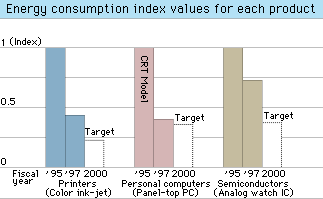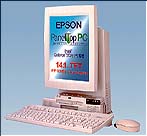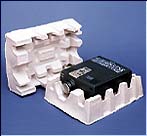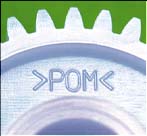 |
Lower and Lower Consumption Using Fewer and Fewer Resources Taking the First Step |
|
| Seiko Epson started out as a maker of watches, a product in which saving materials has always been a key consideration. Since the founding of the company, our business has developed using Energy-Saving Technologyモ as one of its core technologies. For example, Seiko Epson quickly realized the importance of printers and display devices in the information society, taking conventional large devices and shrinking them until they could be held in the palm of the hand. We also began marketing LCD display devices that use far less energy than CRT or LED displays.
As environmental awareness has increased in recent years, the |
|
development of products with reduced environmental impact has accelerated to a higher level. Considering energy saving as the highest priority of environmental concern, Seiko Epson continues new product development with the goal of improving the energy consumption of its major products by 50 percent in fiscal year 2000 (compared to fiscal year 1997). Furthermore, product assess-ment aimed at advancing development of environ-mentally harmonious products with reduced environmental impact has been introduced in all divisions of Seiko Epson. Research aimed at introducing LCA* (Life Cycle Assessment) continues. |
*LCA: Method for evaluating the environmental impact of the natural resources and energy used by a product, together with its emissions, from procurement of raw materials, through design, manufacturing, use, recycling, until its final disposal.
Developing energy saving products
| The product development process begins with setting an energy saving target that takes into account the characteristics of each product. For example, because an overwhelming percentage of energy consumption in the life cycle of a printer occurs while it is being used by the consumer, the energy consumption during actual use, including standby power, is reduced.
Seiko Epson has started marketing its new panel-top PC, with greatly reduced energy consumption. |
|
This reduction is accomplished by using an LCD display in place of a CRT display with its high energy consump-tion, along with improvements to the power supply. This product became the pioneer in the panel-top PC market. Energy saving has become a uniting theme for electronic devices such as semiconductors, LCDs, and crystal devices as development of products that reduce electrical consumption continues to advance. |
 |
|
 Panel-top PC
Panel-top PC
|
Product assessment implementation
| Efforts to develop environmentally harmonious prod-ucts start at the design stage. Products are assessed and improvements made after considering weight reduction, use of recycled materials, ease of disas-sembly, separation, sorting for disposal, and energy savings. The assessment and improvement process is also applied to packaging. To help designers to implement the product assessment process in the design stage, the evaluation method was made as simple as possible while still providing highly accurate results.
In the Imaging and Information Products Operations Division, which produces printers and scanners, product assessment was implemented for all new products in fiscal year 1998, and was applied to approximately 30 models. |
|
 Molded pulp cushioning material
Molded pulp cushioning material
|
|
Points for evaluation in product assessment
|
Improving recyclability to save natural resources
| Material name marked on a plastic partSeiko Epson is making progress in its efforts to save natural resources by reducing the size and weight of its products and the number of parts. Plans are also being made to increase the recyclability of products and their parts. For efficient recycling, the parts must be separated and sorted by materials, establishing the responsibility of marking all plastic parts of 25 grams or more with the names of their materials. Lighter parts are marked whenever possible. An example of the use of recyclable materials is the adoption of molded pulp cushioning materials for packaging. These cushions are made from old newspapers. This cushion-ing is not only for use with lightweight products. Its range of applications has been expanded to include large LCD projectors weighing over 10 kilograms. |
|
 Material name marked on a plastic part
Material name marked on a plastic part
|
|
|




